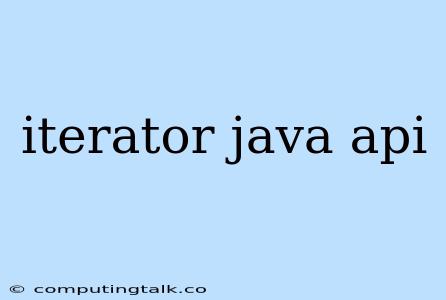Exploring the World of Java Iterators: A Deep Dive
Java's robust ecosystem is built upon powerful constructs like iterators, which are fundamental to navigating collections efficiently and elegantly. An iterator acts as a conduit, allowing you to traverse through elements within a collection without needing to know its underlying implementation details. In this exploration, we'll delve into the depths of Java's iterator API, uncovering its essence and the advantages it brings to the table.
What Exactly is a Java Iterator?
At its core, a Java iterator is an object that implements the java.util.Iterator interface. This interface mandates the presence of three crucial methods:
hasNext(): This method tells you whether there are more elements left to iterate over.next(): This method retrieves the next element in the sequence and advances the iterator's internal pointer.remove(): This method, optional in some cases, allows you to remove the last element returned bynext().
The beauty of iterators lies in their separation of concern. They abstract the process of traversing a collection, allowing you to focus on the logic of your operation without worrying about the collection's internal structure.
Why Use Iterators?
Iterators bring numerous benefits to the table, making them indispensable for effective collection management:
- Abstraction: Iterators provide a consistent interface for navigating collections, regardless of their underlying implementation.
- Flexibility: You can use the same iterator to traverse different types of collections, promoting code reusability.
- Modularity: Iterators enable you to separate traversal logic from the main program flow, enhancing code organization.
- Efficiency: Iterators can offer optimized traversal strategies for specific collection types.
- Control: Iterators grant you fine-grained control over the iteration process, allowing you to modify the collection as you traverse it.
Implementing the Iterator Pattern: A Simple Example
Let's illustrate the power of iterators with a simple example:
import java.util.ArrayList;
import java.util.Iterator;
public class IteratorExample {
public static void main(String[] args) {
ArrayList names = new ArrayList<>();
names.add("Alice");
names.add("Bob");
names.add("Charlie");
Iterator iterator = names.iterator();
while (iterator.hasNext()) {
String name = iterator.next();
System.out.println(name);
}
}
}
In this example, we create an ArrayList of names. We then obtain an iterator from the list using the iterator() method. The while loop iterates as long as there are elements in the list, retrieving each element using the next() method.
Beyond the Basics: The Java Iterator API
The java.util.Iterator interface provides a basic foundation for iterating, but the Java API extends its capabilities through other important interfaces:
java.util.ListIterator: This interface extendsIteratorand offers additional methods specifically designed for lists. These includeprevious()to traverse in reverse order andadd()to insert elements.java.util.Enumeration: While not directly related to iterators,Enumerationprovides a similar functionality for iterating over collections, albeit with a slightly older syntax.
The Power of Iterators: Practical Applications
Let's dive into practical scenarios where iterators excel:
- Filtering Elements: You can use iterators to filter elements from a collection based on specific criteria.
- Modifying Collections: Iterators allow you to modify the underlying collection during iteration, such as removing or adding elements.
- Parallel Processing: Iterators can be combined with parallel processing techniques to speed up complex operations.
Conclusion: Unlocking the Potential of Java Iterators
Iterators are a cornerstone of Java's collection framework, providing a powerful and flexible mechanism for traversing and manipulating collections. By understanding the fundamentals of iterators and mastering their usage, you can write more elegant, efficient, and reusable Java code.
Remember, iterators are your allies in navigating the world of Java collections. Embrace their power, and unlock a whole new level of control and efficiency in your programs.
